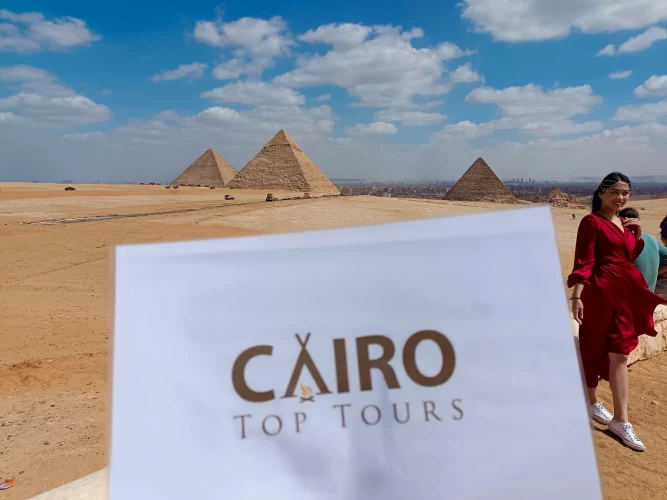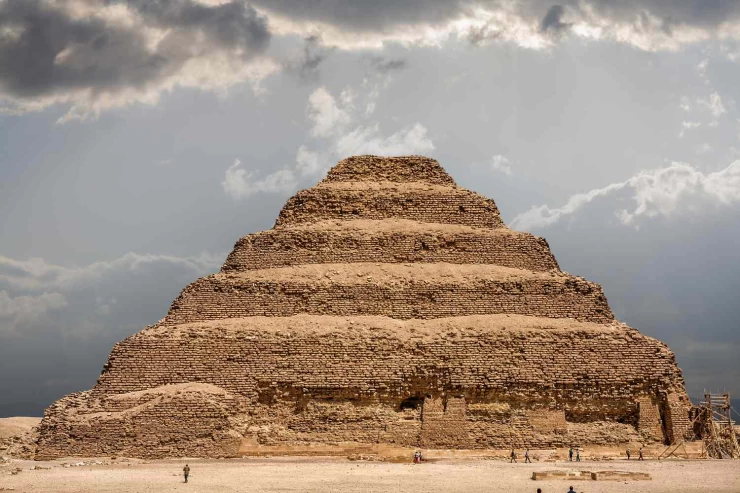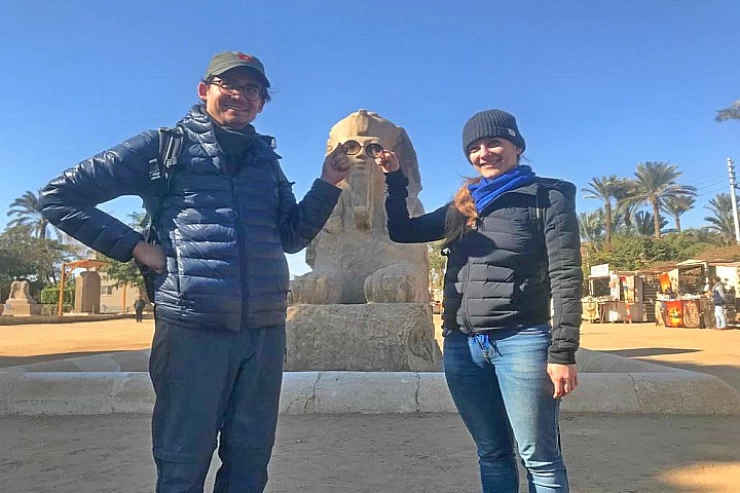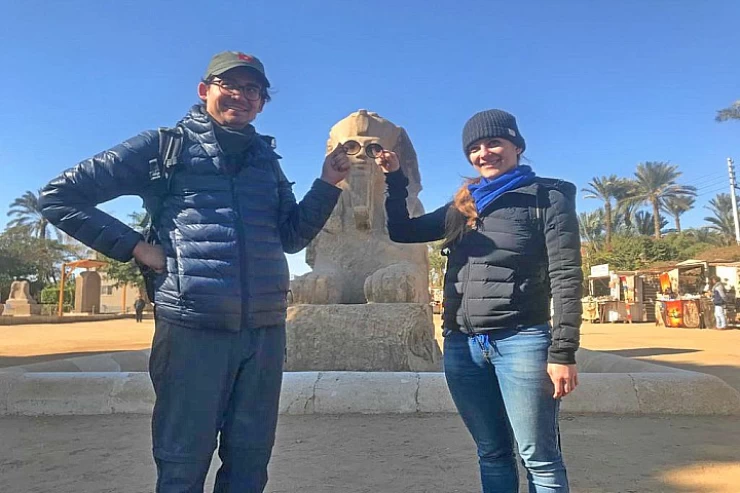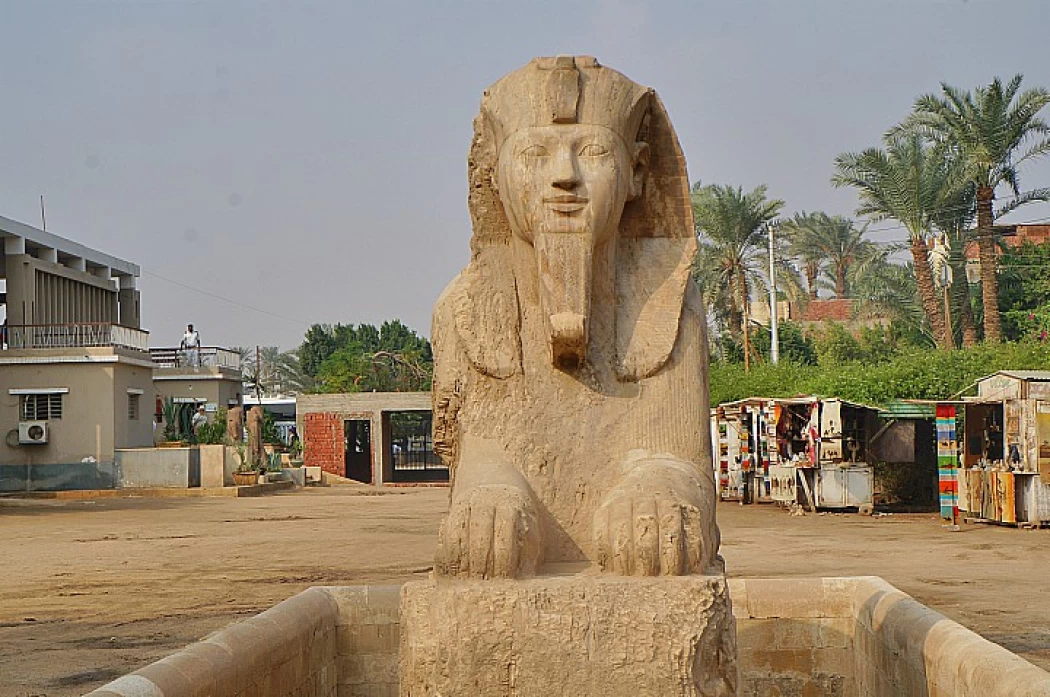
Memphis '' Ancienne capitale de l'Égypte ''
Memphis '' Ancienne capitale de l'Égypte ''
Memphis, l'une des villes les plus anciennes et les plus importantes de l'Égypte antique, était située près du plateau de Gizeh, à l'embouchure de la vallée du Nil. Elle était à la fois la capitale de l'Égypte antique et un important centre de culte.
Memphis est l'un des sites archéologiques et des activités les plus fascinants du Caire. C'était l'ancienne capitale de l'Égypte bien connue autrefois sous le nom de ``Inebu-haie'', le nom qui ne pouvait pas être prononcé par les Grecs, ils l'appelaient donc d'après le nom de l'une des pyramides à l'emplacement de la ville, la pyramide est appelé Mn Nefer qui signifie joli et stable. Mn-Nefer a été corrompu pour être Memphis alors les Arabes ne pouvaient pas le dire alors ils ont appelé la ville Manf, et ce nom a finalement été prononcé par les Egyptiens modernes. Comme Mit-Rahina et cela reste le nom actuel où une telle ville cosmopolite était autrefois ancienne. C'était le prénom de la Basse-Égypte à cette époque. Il a été fondé par le pharaon Menes et était la capitale de l'Égypte pendant l'Ancien Empire, les ruines se trouvent près de la ville (Mit Rahina) à environ 20 km au Sud de Gizeh. C'est à une position stratégique à l'embouchure du delta du Nil, c'est pourquoi elle est restée une ville incontournable tout au long de l'histoire de l'Égypte ancienne. Son port principal contenait une forte densité d'entrepôts qui distribuaient de la nourriture et des marchandises dans tout l'ancien royaume. Des ateliers, des usines et vous devez vous rappeler que pendant son âge d'or, Memphis a prospéré en tant que centre régional de commerce, de religion et de commerce.
Dans une zone archéologique limitée où se trouvait le temple de Ptah, Ptah est considéré comme la principale divinité de Memphis, il était vénéré comme le dieu créateur, et sa femme Sekhmet et leur fils est Nefertum.
Il y a quelques statues colossales exposées dans le musée moderne de Mit Rahina, la plus grande est celle représentant Ramsès II retrouvé démoli et mutilé, à l'origine plus de 13 m de haut.
Memphis est devenue la capitale de l'Égypte ancienne pendant 1000 ans au cours de huit dynasties consécutives pendant l'Ancien Empire. Il a atteint son apogée sous la 6e dynastie en tant que centre de culte de Ptah, le dieu de la création et des œuvres d'art. Le temple de Ptah, gardé par le sphinx d'albâtre, sert de mémorial de l'ancien pouvoir et du prestige de la ville. La triade de Memphis qui se compose du dieu Ptah, de sa femme Sekhmet et de leur fils Nefertem, a fait l'objet principal du culte dans la ville.
Memphis a décliné pendant la 18e dynastie avec la montée de Thèbes et a été restaurée pendant le reste du Nouvel Empire et aussi sous les Perses avant d'être à nouveau ignorée après la fondation d'Alexandrie. Pendant l'Empire romain, Alexandrie est restée la ville égyptienne la plus importante. La deuxième ville d'Égypte jusqu'à l'établissement de Fustat (ou Fostat) en 641 CE resta Memphis. Dernièrement, il était en grande partie désert et est devenu une source de pierre pour les colonies environnantes. Maintenant, encore, il a encore un ensemble impressionnant de ruines qui appartiennent au XIIe siècle mais qui sont rapidement devenus un peu plus qu'une étendue de ruines basses et de pierres éparses.
Memphis serait sous la protection du dieu Ptah, le patron des artistes. Son magnifique temple, Hut-ka-Ptah était l'une des structures les plus importantes de la ville à cette époque et il ne fait aucun doute que les ruines de l'ancienne capitale offrent aujourd'hui une preuve fragmentée de son passé. Ils sont protégés, avec le complexe pyramidal de Gizeh, comme site du patrimoine mondial depuis 1979. Le site est ouvert au public en tant que musée en plein air.
Des circuits en Egypte remarquables et sûrs ! Avec nos circuits de Pâques en Égypte 2023, vous ressentirez la grâce de l'esprit antique des Égyptiens en explorant les majestueuses pyramides, les temples, les tombeaux qui hantent votre esprit et votre âme tout en bénéficiant du meilleur service. Des meilleures croisières sur le Nil aux forfaits classiques de visites de sites historiques, Cairo Top Tours propose une gamme d'activités et de vacances d'aventure en Égypte. Outre les sites historiques traditionnels, nous proposons une sélection distinctive de safaris dans le désert égyptien à travers le silence magique et l'attrait des oasis de Siwa, dans le désert égyptien. Choisissez parmi les meilleures offres d'excursions d'une journée en Égypte et choisissez l'une de nos superbes excursions d'une journée au Caire. Nos passionnantes excursions à Louxor et excursions à Assouan vous feront découvrir tous les chefs-d'œuvre historiques de la ville. Notamment la fascinante Vallée des Rois, le fantastique temple de la reine Hatchepsout et les temples uniques d'Abu Simble, le tout accompagné d'un guide expert qui vous expliquera l'histoire de ces incroyables sites.
Si tu es curieux de connaître la ville de Gizeh et de savoir à quoi elle ressemblait il y a longtemps, tu peux consulter un site web intitulé "Is It safe to travel to egypt ? Il contient des informations intéressantes, comme des photos et des faits sur Gizeh, qui t'apprendront tout sur son histoire.
Located on the western banks of the Nile, southwards of Cairo stands one of the most significant historic and archaeological centers in Egypt, Memphis. This ancient metropolis existed as the capital of Egypt for approximately two thousand years from its establishment about in 3100 BC until it was overtaken by the might of Thebes and Alexandria. Given its foundation at the very earliest periods in Egyptian history and civilization, we can safely conclude that Memphis was more than just an administrative and political area but had active religious practice. Nowadays, although most of Memphis has perished over the years, the few remains still help one to piece together the colorful history of Egypt.
Let’s embark on a mission to unearth the beauty of Memphis and its history by visiting its fabulous buildings, temples, and sculptures that have endured the test of time.
The Birth of Memphis: A Historical Overview
According to popular belief, Memphis was founded by King Mena oder Narmer, who was the first ruler to unite Upper and Lower Egypt into one kingdom around 3100 B.C. Memphis, or Ineb Hedj, as the ancient Egyptians named it (translated into English as White Walls), was, on the other hand, quite favorablely located, at the delta of the Nile, where the river finally met the enormous desert. This made it a center on transport and trade activities, which connected Egypt with the Mediterranean Sea, Africa, and almost the entire world.
It did not take long before Memphis became an affluent city and the center of governance, economy, and arts in Egypt. In the course of history, it survived and thrived in the course of multiple periods of dynasties, with the Egyptian kings erecting grand and expensive palaces and temples as well as tombs. Such influence of the city lasted until the period of the Greco-Roman domination when Alexandria took over the center of power and Memphis started losing its significance over time.
Besides being the seat of power, Memphis was one of the chief religious centers in the entire ancient Egyptian world. It was here that the chief god, Ptah, was the god responsible for creation and crafts, with many temples dedicated to him and pilgrimage worshipers and qualitatively provided all over Egypt. As a passive creator, ‘one who brings into existence only by the utterance of a word’, it is easy to think why he was so significant to the hierarchy of the Egyptian gods. The most prominent temple within the city, the Temple of Ptah, dedicated to this god, attracted a great number of visitors and worshippers coming from different parts of Egypt.
In due course, more deities came to be worshiped in Memphis, such as Sekhmet, the warrior goddess of the lion’s head, who prophetically wards diseases, and Nefertem, the lotus god of regeneration. They were also known as Ptah’s family together with God Ptah, where they enhanced religious activities in the city of Memphis as religious activities became more focused.
Ruins have taken over a large section of Memphis today; however, whatever is left gives a snapshot of the city in its glorious days. Below are some of the most notable structures that have survived the test of time:
1. Temple of Ptah Statue
The Temple of Ptah is regarded as the center of all temples in Memphis and is arguably the 2nd Largest Temple in Ancient Egypt. Great losses have been incurred by the temple throughout time; however, archaeological excavations have retrieved traces of its pillars, images, and altars.
The temple complex also comprised several matrixes of courts, shrines, and chapels connected by hallways in which priests conducted rituals and offered sacrifices. Today the visitors will notice some broken colossal statues of the pharaohs that exist within the premises of the temple, showing the temple in its full splendor.
2. The colossal Statue of Ramses
One such famous monument of Memphis is the enormous limestone statue of Ramses II. Which is supposed to have been more than 30 feet high when standing with the statuette depicting the pharaoh in a striding position intricately decorated with several details of the headdress and attire worn by the king.
At the moment the statue is on display horizontally in the Memphis museum, enabling the audience to see the workmanship and proportions better. The Cairene sculptor in a low classical style statue of Ramses II holding a scepter in Memphis is indicative of one of the great kings of Egypt and also one of Egypt's greatest legacies.
3. The Alabaster Sphinx
Situated close to the gigantic image of Ramses II, the Alabaster Sphinx is a stunning artwork that weighs around 80 tons, stands roughly 13 feet in height, and extends 26 feet in length. It is assumed to have been created during the reign of Amenhotep II (18th Dynasty) and is believed to depict either him or his heir.
In contrast to the Great Sphinx of Giza, which was built out of limestone, the Alabaster Sphinx is made of one piece of alabaster, which is a sweet translucent stone. It is beautifully serene, and the features are expertly sculpted, which shows the emotions of Egyptian art vividly.
4. The Burial Tomb of Horemheb
General Horemheb, who would later assume the title of king, is interred in a sarcophagus that has been placed inside the Saqqara complex; however, he had stronger associations with Memphis. While Tutankhamun sat on the throne, he served in a prominent position as commander within the city and therefore knew its corridors too well. His is a handsome tomb covered with reliefs of his victories and greatness in arms.
This tomb provides much pertinent information on the 18th Dynasty as well as the political climate of Memphis during the reign of Horemheb in terms of arts and culture.
Recent Discoveries: Unearthing Memphis’ Hidden Treasures
Memphis remains a hotbed of archaeological activity today, with recent findings opening new windows into the previously obscure city. The remains of ancient statues, sarcophagi, and other pieces of art have been excavated from several periods of history in Memphis, which contributes to understanding this corner of the world.
In the hot seasons of recent years, archeologists dug up a high number of Sekhmet’s statues, which means that she and her worshippers’ devotion was cosmically present in Memphis. Moreover, ascertaining factors about their lives has also been demonstrated by the discovery of sepulchers of priests and other city officials, as well as that of artisans who were responsible for serving the city’s temples.
Memphis’ Legacy: The Rise and Fall of an Ancient Capital
Memphis was more than a political seat but a cultural and intellectual powerhouse. The city attracted many artists, scribes, and scholars, all of whom played a part in the artistic and literary development of Egypt. However, this was true until other regions grew into power; the seat of governance was moved to Thebes and later Alexandria, leading to the stagnation of Memphis.
Economic decline in the city occurred at a slow pace, but it was already noticeable during the Roman occupation. With the rise of Alexandria as the major educational and commercial hub, the temples and monuments of Memphis were neglected, and the city itself was eventually buried beneath the shifting sands of the Nile Delta.
Visiting Memphis Today: A Step Back in Time
Even though the majority of ancient Memphis has been reduced to ruins, the location is a significant place for people who are interested in the history of Egypt. The open museum that is found in Mit Rahina depicts the resplendent past of the city, with sculptures, sphinxes, and pieces of temples set in a calm environment.
Guided Tours: A guided tour is advisable since a narrative accompanying the monuments adds value to the monuments. A well-informed guide is capable of animating the ruins, making the visit worthwhile.
Combine with Saqqara: Expect Memphis to include a Saqqara tour as the Saater cemetery is just a few kilometers away. This is the best way to understand the evolution of funerary architecture and practices in general in ancient Egypt.
Photography: The place is also very good for photography, particularly for the giant statues and the Alabaster Sphinx. The old statues can be more delightful in the morning or evening when the light is not harsh.







